Paludiculture Newsletter 4|2024
General information and news on peatlands and climate
Yeah! German Environmental Award!

One of the most highly endowed environmental awards in Europe goes to... Franziska Tanneberger from the GMC and thus for the third time to a person involved in peatland research.
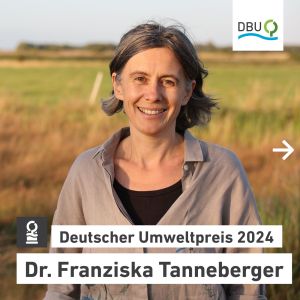
Dr Franziska Tanneberger receives the German Environmental Award from the Deutsche Bundesstiftung Umwelt (DBU) 2024, recognising the co-director of the Greifswald Mire Centre (GMC) as one of the world's most influential researchers on peatlands and their role in climate and biodiversity. She is regarded as a driving force in the revitalisation of peatlands and as a bridge builder between science, politics and agriculture. She shares the award with graduate engineer Thomas Speidel from Nürtingen near Stuttgart.
This is the third time in a short space of time that one of the most highly endowed environmental awards in Europe has gone to a representative of peatland research in Greifswald. In 2021, ‘Moorpapst’ Prof Hans Joosten was one of the two winners of the annual award, which is endowed with a total of 500,000 euros. In 2015, Prof. Michael Succow was honoured with the honorary prize as an exceptional personality in nature conservation. On 27 October, Federal President Frank-Walter Steinmeier will present this year's German Environmental Award in Mainz.
‘As an excellent and globally recognised peatland researcher, Franziska Tanneberger and her team have worked tirelessly to place the importance of peatland protection and rewetting for a future worth living in political decision-making processes both nationally and internationally,’ explains DBU Secretary General Alexander Bonde.
A landscape ecologist by training, she completed her doctorate on the sedge warbler and wrote her post-doctoral thesis on ‘Biodiversity and ecosystem services of near-natural and rewetted fens in Central and Eastern Europe - between wilderness and paludiculture’. Today she teaches and researches at the University of Greifswald. Since 2015, Dr Franziska Tanneberger has headed the Greifswald Mire Centre together with Dr Greta Gaudig, a cooperation between the University, the Michael Succow Foundation and Duene e.V.. She is a member of the German Federal Government's Council for Sustainable Development (RNE).
German Unity Day - not without peatlands
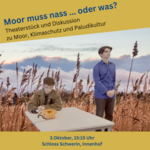
Peatlands in the inner courtyard of Schwerin Castle - that's what you'll find on October 3 at the celebrations for German Unity Day. The GMC offers a combination of theater and expert talk on the Zukunftsforum stage, entertaining and for all...
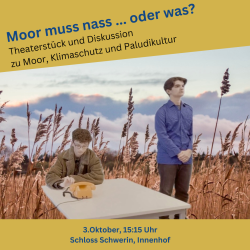
Mecklenburg-Vorpommern is hosting the multi-day celebrations for German Unity Day this year. An opportunity to present the state's moors and research with a look into the past and perspectives for the future - packed into a varied program. Entertaining, open to the public and free of charge on Thursday, October 3 from 15:15-16:45 on the Zukunftsforum stage in the inner courtyard of Schwerin Castle:
15:15 “Moor muss nass, oder was” - A play by the 9th grade of the Martinschule Greifswald: the moor researcher Prof. Dr. Hans Joosten from Greifswald manages to travel into the GDR past to the year 1958 with the help of Mephisto. There, thousands of young people are busy draining the Friedländer Große Wiese, a vast peatland in Mecklenburg-Western Pomerania. Why are they doing this, will the professor succeed in convincing the young people to stop their work and what plans is Mephisto actually pursuing?
15:45 Back in the present, the students meet the bog professor in real life. They ask him questions: Why would Joosten have preferred to stay in the past and why did the enthusiasm of the past turn into the disaster of today?
16:00 What potential does paludiculture offer for agriculture and the economy? What needs to happen politically for more paludiculture and how can research contribute to this? Dr. Franziska Tanneberger (GMC Director/University of Greifswald), Dr. Till Backhaus (Minister for the Environment and Agriculture MV), Tobias Gruber (Division Manager Sustainability OTTO Group) and farmer Rembert Wellen will discuss these issues. The event will be moderated by Jan Meßerschmidt, Head of University Communications at the University of Greifswald.
New information paper on paludiculture and biodiversity

Everything important in brief, whether positive or negative effects of paludiculture on biodiversity, possible conflicts, influencing factors and accompanying measures in the new information paper ...
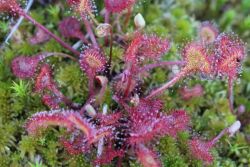
Compared to agriculture on drained peatland, paludiculture promotes biodiversity, as the new information paper of Eberswalde University of Sustainable Development, Peatland Science Centre and Greifswald Mire Centre summarizes. It’s clear: typical peatland and peatland-specific species have no habitat on drained peatland soils. If and which they have on cultivated rewetted areas, is meanwhile shown by studies in several areas. For example, the number of Red List species of birds has doubled within four years on a cattail cultivation area in Mecklenburg-Western Pomerania. On a peat moss cultivation area in Lower Saxony, the number of dragonfly species typical to bogs almost equals that of near-natural bogs in the area after nine years of observation.
After rewetting, wetness-loving and rare species are found where previously widespread species of moist or dry conditions dominated. The intensity of use, mowing and harvesting time have different effects on these species. The mowing of areas creates a more species-rich vegetation due to less litter, more light incidence and leaching. In winter, however, this causes a lack of host plants and winter refuges for some animal species. The information paper addresses both negative and positive aspects, as well as possible conflicts with nature conservation and accompanying measures that can promote biodiversity
IMCG excursion 2024 – from the Alps to the seashore
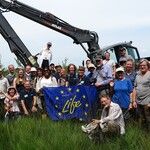
For the 20th Field Symposium of the IMCG 30 peatland specialists embarked on a 10-day-tour through Germany. It resulted in a call to cease peatland-damaging amber extraction in Ukraine and for strategic peatland decisions in the European Union.
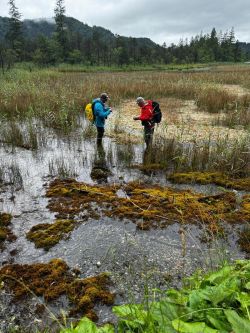
Germany’s few remaining intact peatlands are invaluable, serving as prime examples of the fine-tuned dynamics of these unique systems that offer sanctuaries for rare peatland plant and animal species. The urgent need to protect these areas and restore the vast stretches of degraded peatlands across the country remains a top priority.
That‘s what global peatland experts agreed on after the 20th Field Symposium of the International Mire Conservation Group (IMCG) was held in Germany this summer. It brought together over 30 peatland experts and enthusiasts from 17 countries, including six EU Member States. Donning their rubber boots, participants embarked on a 10-day journey across Germany’s peatlands. The IMCG, an international network of experts, is dedicated to promoting and encouraging the conservation of mires and related ecosystems, while also facilitating the exchange of information and experiences globally. With over 550 contacts in nearly 60 countries, the network plays an important role in peatland preservation.
German peatlands, though covering a relatively small area, hold significant global ecological and environmental importance. Alarmingly, degraded peatlands account for 7% of Germany’s total greenhouse gas emissions, making them a major contributor to global peatland emissions. Drawing on expertise from across the globe, through observation, discussions, and exchanges with local experts during the excursion, participants drew up recommendations for peatland conservation and restoration in Germany and the European Union. The IMCG emphasised the importance of protecting Germany’s remaining mires and integrating these systems in to the broader landscape.
Key resolutions from the IMCG 2024 in Germany
-
A proposal to grant protective status to the Pfrühlmoos in Bavaria
-
A call to cease amber extraction in Ukraine where it threatens peatlands
-
A resolution to the European Commission and EU Member States on strategic directions for peatland management
Travelling from southern to northern Germany, the IMCG explored a variety of peatlands, including some of the best-preserved areas in Germany such as the Pfrühlmoos in Bavaria. As the group travelled north into the lowlands, they encountered deeply degraded sites, areas of ongoing peat extraction, and promising locations where renaturation efforts are beginning to show success. They also visited sites putting paludiculture into practice, such as Sphagnum farming in Hankhausen (Lower Saxony), Typha fields in Neukalen (MV), and the wet meadows of the Klimafarm in Schleswig-Holstein—demonstrating the broad potential of paludiculture. Further stops included the Freisinger Moos (Bavaria), the Hannoversche Moorgeest and the Eider-Treene-Niederung (both in Neidersachsen) as well as the Peene Valley in Mecklenburg-Western Pomerania.
What made this excursion truly special was the coming together of global and local experts, spanning generations and disciplines, united by their passion for peatlands. This enthusiasm was palpable in the long discussions, avid debates, and stories shared throughout the trip. Despite the occasional stuck boot and waist-deep dips in spring holes, the group emerged unscathed, finishing the trip on a musical note—singing from the Anklamer Stadtbruch observation tower, overlooking the peatland below.
This gathering of minds and exchange of ideas leaves a lasting impact, driving forward the urgent work of peatland conservation and restoration in Germany and beyond.
Background: the IMCG and its excursions
The International Mire Conservation Group (IMCG) is an international network of specialists who promote and encourage the conservation of mires and related ecosystems. It also aims to enhance exchange of information and experience relating to mires internationally. The network currently has over 550 contacts in almost 60 countries. It was established 1984, in Klagenfürt, Austria, and officially registered in France as an association in 2001.
At irregular intervals, the IMCG gathers its members for an excursion to the peatlands of a country, in 2024 for the first time in Germany. Over nine days, the programme took the researchers to peatlands from the south to the north of the country, including intact peatlands with unique biodiversity, restored peatlands and rewetted areas used in paludiculture.
Previous excursions took us e.g. to South Africa (2022), Mongolia (2019), the Netherlands (2018), Russia (2018), Malaysia, Borneo and Brunei (2016), Belarus (2014), Austria (2014), Australia (2013), the Andes (2012) and Argentina's Tierra del Fuego (2005).
Autorin: Amelie Hünnebeck-Wells, Greifswald Mire Centre
A project presented
Plant3-WieMoDämm
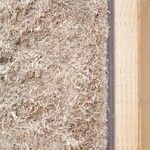
The WieMoDämm project in the Plant3 alliance is looking for high-quality refinement of plant-based raw materials in north-east Germany, naturally also from paludicultures.
WieMoDämm aims to optimise the use of paludiculture biomass as sound and heat insulation. Among other things, this involves converting, modifying and improving existing machines in order to be able to produce the insulating material on a large scale and then incorporate it into the walls of residential and industrial buildings. The right mix of fibres is also important. The researchers want to develop the best recipe to maximise the insulating properties of the paludiculture material. Sedges, canary grass, reeds and bulrushes are being tested as potential plant species. The scientists are also looking for new ways to use the fibres and insulating materials and to open up marketing channels. If this is successful, the project will increase the incentive for farmers to rewet their drained areas and switch to paludiculture.
Initially, the participants will produce prototypes on a laboratory scale, on which they will carry out initial tests with regard to the properties as a wall structure. Later, they will construct large-format components to see whether there are any problems that need to be overcome during series production or installation.
The WieMoDämm project is managed by Hanffaser Uckermark e.G. The University of Greifswald, Wismar University of Applied Sciences and GEKO Maschinenbau GmbH are partners in the project. The project was launched on 1st April 2024 and will run until the end of 2025. It is funded as part of the "WIR! - Wandel durch Innovation in der Region" programme of the Federal Ministry of Education and Research (BMBF). The project sponsor is Forschungszentrum Jülich GmbH (FZ Jülich).
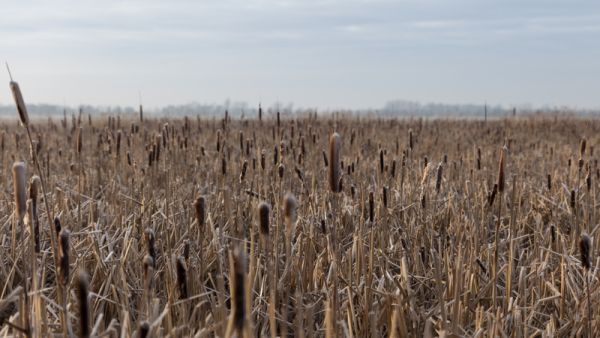
News from other paludiculture projects
Here is the shipping box with paludi fibres
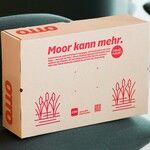
Paludi biomass can make shipping boxes more climate-friendly. The mail order company OTTO is therefore testing a cardboard box with a proportion of sedge hay. Karla Jabben, Sustainability Manager at OTTO GmbH & Co KG, explains how production went and how the new parcel is being tested in shipping for two months.

Ms Jabben, how did the idea for the shipping box with paludi fibres come about at OTTO?
At OTTO, we look at the big picture. We believe that we can make a contribution to climate protection with paludiculture and make the issue bigger together with other companies.
As a graduate environmental scientist, I am always looking for innovative packaging together with my colleagues in the Sustainable Development department and we also have experience from other pilot projects. We have learned about this thanks to the toMOORow initiative.
There were several reasons why the packaging sector was an obvious choice for a first "paludiculture product": Paludi biomass is the easiest to integrate into the production chain here and customers are actively requesting sustainable packaging. A shipping box is our first touchpoint with the customer. It may not attract the most attention and quickly ends up in the bin, but the expectations are still high. The sustainability of the carton should be visible without the customer having to read long texts. With this cardboard, we can communicate the topic briefly and well on the cardboard itself and around it.
Have there already been any calculations on the carbon footprint of cardboard with paludi fibres, i.e. how much CO2 can be saved?
No, not yet. We started the project out of idealism and we are now looking at the concrete figures as we progress. Comparisons with existing OTTO products will help us here, for example with regard to the use of water in production or the risk of deforestation. In the end-of-life balance, we look at where the shipping box goes when it is disposed of, how well it is recycled and whether it causes disruption in the reprocessing of the material. The climate assessment comes towards the end of the test phase.
What exactly is the paludiculture biomass in the shipping box and where does it come from?
It is sedge hay. A farm from Mecklenburg-Vorpommern delivered 194 bales of 210 kg each from last year's autumn harvest of approx. 80 ha of wet peatland to the processor creapaper.
There are various scenarios for purchasing. We have not yet worked with farms ourselves, but we are also considering direct purchasing. This could make a difference to the price or minimise the procurement risk.
And what proportion of the paludiculture biomass is in the carton? How much of it was produced?
We have produced 100,000 of the Paludiculture cartons. The shipping box consists of 75% recycled paper, 15% virgin fibre and 10% paludiculture biomass. We started with a rather low proportion of paludiculture biomass, but will also test a higher proportion in the future. However, the stability of the shipping box still has to be guaranteed and too much paludiculture biomass would probably interfere with disposal. However, the paludi content will never be huge and will not exceed 30%.
The proportion of virgin fibre is of course always a dilemma for us and should never be higher. We want to avoid virgin fibre in cardboard boxes.
What were the findings from production?
The creapaper company converted the biomass into pellets for us, producing the raw material, so to speak. Processing was straightforward and the shape of the pellets ensures homogeneous mixing with the other components. The packaging manufacturer Mondi then produced the shipping boxes on a pilot machine. That went without a hitch. However, we don't yet know how the material would behave on the normal machine. The paper webs would be slightly larger there.
What happens next in the test phase?
The test phase is scheduled to last two months, but also depends on the type of orders. The shipping box is intended as packaging for certain products in certain sizes or quantities, and these must be ordered in sufficient quantities.
In addition to the information printed on the outside of each box, there is an insert made of paper, which is also made from paludiculture biomass. The insert explains the new packaging and directs customers to an online questionnaire using a QR code. Unfortunately, we were unable to combine the survey with an incentive, such as a small shopping voucher, as was the case with some previous customer surveys. However, we have already received a response to our questionnaire.
We are also looking at how the shipping box performs in logistics. Does it keep its shape, does it tear, how does it behave when it rains on the delivery route?
Then recyclability is very important. We have this tested by laboratories in advance, but the process at the customer's premises is difficult to control. In the best case scenario, the shipping box goes into the waste paper and then to a waste disposal company. By returning the cardboard to OTTO, where it can be collected "unmixed" and passed on to a disposal company, we gain good insights into recycling that can be transferred. For example, whether machines become clogged or dirty and whether recycling would become more expensive due to maintenance and labour costs.
And what happens after the test phase? What is your best case scenario?
In the best case scenario, the shipping box works well in the logistics processes, is accepted and rated well by customers, and performs really well compared to existing packaging in terms of production and end-of-life balance with a recyclability of over 90%. We manage to develop scenarios for price and supply to make the whole thing bigger.
After an overall assessment, we know where we need to make adjustments, possibly to the size of the shipping box or the type of biomass. A lot depends on the availability and type of processing. For the pilot, the stalks were mechanically defibred, but we are also considering other processing methods. Chemical defibration provides longer and more stable fibres, but of course requires the use of chemicals. The high silicate content in biomass from paludiculture could be problematic here. There are thermal processes for which the energy input is crucial.
I think it's unlikely that the shipping box will be the final product for our packaging, but our current test is already making a promising impression.
Interview by Nina Körner and Clemens Kleinspehn.
Background:
The OTTO Group is one of 14 companies who joined forces as an “Alliance of Pioneers” to build scalable value chains based on paludiculture biomass. The Alliance of Papers has developed out of the toMOORow initiave of Environmental Foundation Michael Otto and Michael Succow Stiftung. In the PaludiAllianz project, the Environmental FoundationMichael Otto, the University of Greifswald and the Succow Foundation have been coordinating and supporting the growing alliance of interested companies since April 2024. Among other things, they offer the participating companies from the various economic sectors expert Circles, e.g. on building materials or paper and cardboard packaging. The almost 3-year joint project PaludiAllianz is funded by the Federal Ministry of Food and Agriculture (BMEL) via the Agency for Renewable Resources (FNR) from the special fund “Climate and Transformation Fund (KTF)”.
Caterpillar & Sphagnum & harvest – thumbs up for this combi
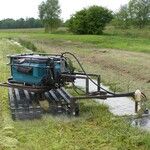
It is light, flexible and cultivates and harvests peat moss without a driver. Researchers at mera Rabeler GmbH & Co. KG have optimized a remote-controlled lightweight caterpillar for use in Sphagnum cultures.
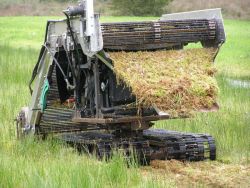
Up to now, peat moss has been harvested with an excavator from a driving dam. However, the dams require a lot of space and the excavator is too heavy to drive directly on wet peat soil. This is why a machine is needed that can drive directly over the peat moss culture to maintain and harvest it. This lack of technology for cultivating Sphagnum crops is currently still a hurdle when it comes to persuading farmers to switch to paludiculture
However, researchers at mera Rabeler GmbH & Co. KG have now succeeded in constructing a remote-controlled lightweight crawler tractor with wide crawler tracks. This fulfills a sub-task of the GesaSpAn project funded by the FNR. During the field trials, it proved advantageous to lower the water level for harvesting. The crop is lighter and the machine clogs less frequently. For existing crops, it enables a harvesting process that leaves strips of intact, reproducible plants, so that no new planting material is required. Nevertheless, the researchers are also working on a machine that is suitable for spreading seedlings in order to establish new Sphagnum crops.
Events
All current events are compiled in our online calendar.
Literature
Alexiou Ivanova, T., Paramonova, K., Talipov, O., Tanyrbergenov, N., Zhakupov, T., Akayev, A., 2024: Assessment of Common Reed (Phragmites australis (Cav.) Trin. ex Steud.) Biomass Suitability for Solid Biofuels Production. Sustainability 2024, 16, 7378. DOI: 10.3390/su16177378
Chen, C., Lemke, N., Loft, L., Matzdorf, B., 2024: Transformation of peatland management towards climate targets in Europe. Ecosystem Health and Sustainability. DOI:10.34133/ehs.0239.
De Klerk, P., 2024: Vegetation history and landscape development in and around the Friedländer Große Wiese peatland (Mecklenburg-Vorpommern, NE Germany): an integration of palaeoecological and geomorphological data - mit ausführlicher Zusammenfassung auf Deutsch. Greifswald Moor Centrum-Schriftenreihe 03/2024 (Selbstverlag, ISSN 2627‐910X), 53 S
Hochschule für Nachhaltige Entwicklung Eberswalde, Peatland Science Center & Greifswald Moor Centrum, 2024: Informationspapier zu Paludikultur und Biodiversität. 8 S.
Mattila, T.J., 2024: The role of peatlands in carbon footprints of countries and products. Science of The Total Environment, p.174552. DOI: 10.1016/j.scitotenv.2024.174552
Mendiondo, G., Moko, E.M., Sparkes, D.L., Rahardiyan, D., Welham, S.J., O'Reilly, P., Wilson, P., Thomas, M.L., Ngangi, J., Sjögersten, S., 2024: Environmental and farming practice controls of productivity of Cyrtosperma merkusii (giant swamp taro), an underutilised wetland and potential paludiculture crop. Food and Energy Security, 13(1), p.e490, DOI:10.1002/fes3.490
Myllyviita, T., Grönroos, J., Mattila, T., Lång, K., 2024: Climate change mitigation potential of paludiculture in Finland: greenhouse gas emissions of abandoned organic croplands and peat substitution. Carbon Management, 15(1), p.2365903, DOI:10.1080/17583004.2024.2365903
Nielsen, C.K., Liu, W., Koppelgaard, M., Laerke, P.E., 2024: To Harvest or not to Harvest: Management Intensity did not Affect Greenhouse Gas Balances of Phalaris Arundinacea Paludiculture. Wetlands, 44(6), p.79. DOI:10.1007/s13157-024-01830-7
About
This newsletter was produced as part of the PaludiZentrale project and supported by the Greifswald Mire Centre. PaludiZentrale is carried out by the Thünen Institute, the University of Greifswald and the Succow Foundation, both partners in the Greifswald Mire Centre. It is funded by the Federal Ministry of Food and Agriculture (BMEL) through the Agency for Renewable Resources (FNR). F.i.S.d.P.: Nina Körner, Franziska Tanneberger, Merten Minke.









